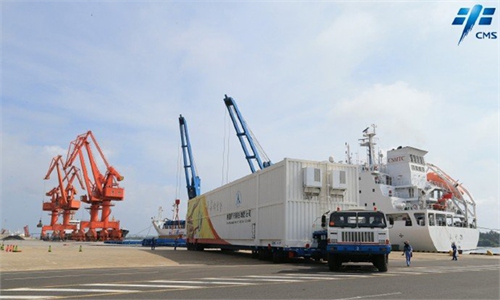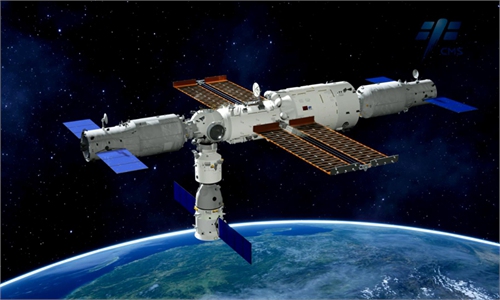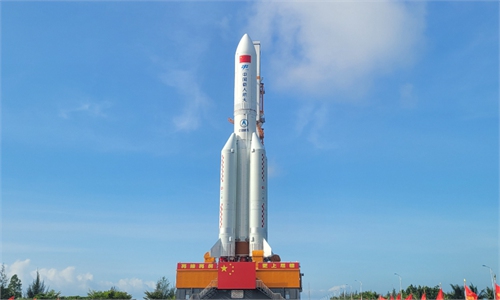China successfully launches Wentian lab module, construction of China’s space station enters full speed stage
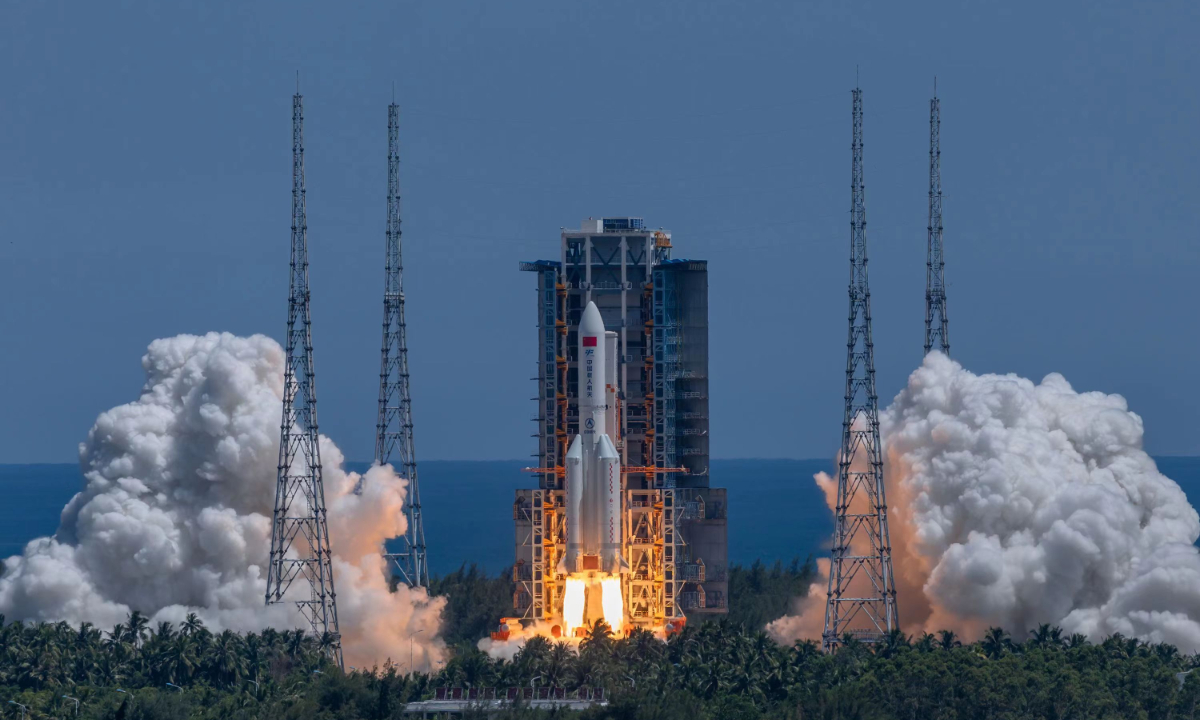
China launches Wentian lab module for space station. Photo: Fan Wei/GT
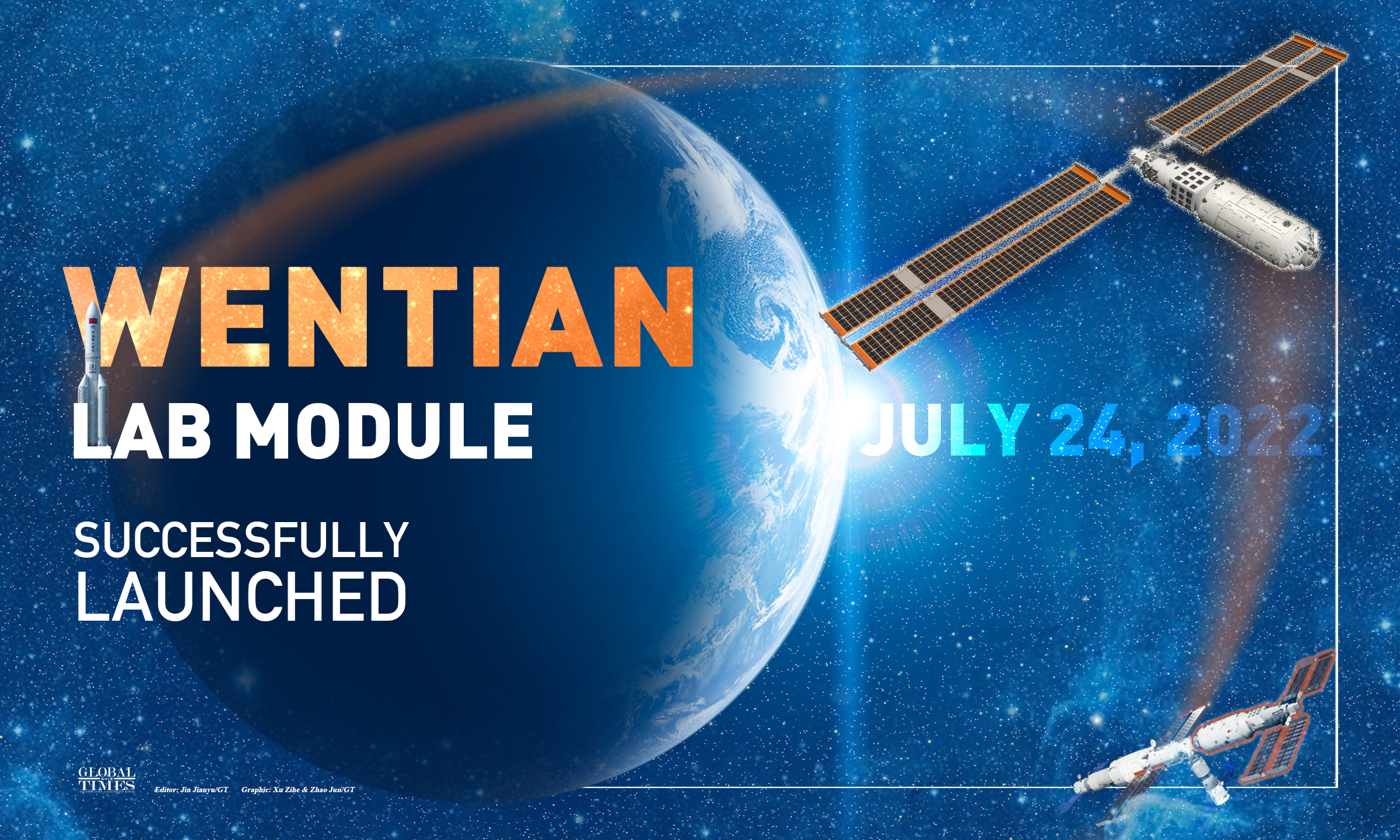
Wentian lab module successfully launched. Graphic: GT
Having moved into China's Tianhe space station core module for more than a month, the Shenzhou-14 crew of three taikonauts are now only hours away from performing their first major missions in orbit, receiving the arrival of the Wentian laboratory module and linking it to the three-module China Space Station.
With the trembling of coconut trees on the coastal line of the South China's tropical island province of Hainan, the giant heavy lift Long March-5B Y3 carrier rocket took off from the Wenchang Space Launch Site at 2:22 pm on Sunday. And after a flight of about eight minutes, the Wentian module separated with the rocket body and entered preset orbit, marking success of the launch mission, the China Manned Space Agency said in a statement it provided to the Global Times Sunday.
Wentian, the first lab module of the country's space station, is expected to carry out a semi-autonomous rendezvous and docking with the space station's Tianhe core cabin in the front port, and in a few hours, the Tianhe space station core module will for the first time receive a new spacecraft while the crew is onboard.

China launches Wentian lab module for space station. Photo: Fan Wei/GT
In the coming months, people on Earth will be able to witness the construction of the China Space Station which will be completed at a speed that has no precedent in mankind's history.
The first ever space station in history, the Salyut 1, launched by the Soviet Union, had its core module delivered to orbit in 1986. In ten years time, the station completed the assembly of six modules with total weight of 130 tons.
The International Space Station (ISS) began construction in 1998 and spent 12 years, with the coordination from 15 countries, to build its 15-module structure.
China Space Station is planned to become operational before the end of 2022, aiming to accomplish the in-orbit assembly of the country's most ambitious program in less than one year and a half, since the launch of Tianhe core module in April 2021.
The third and the final part of the three-module China Space Station basic structure, the second lab module Mengtian, is expected to be launched and connected to the combination by October.
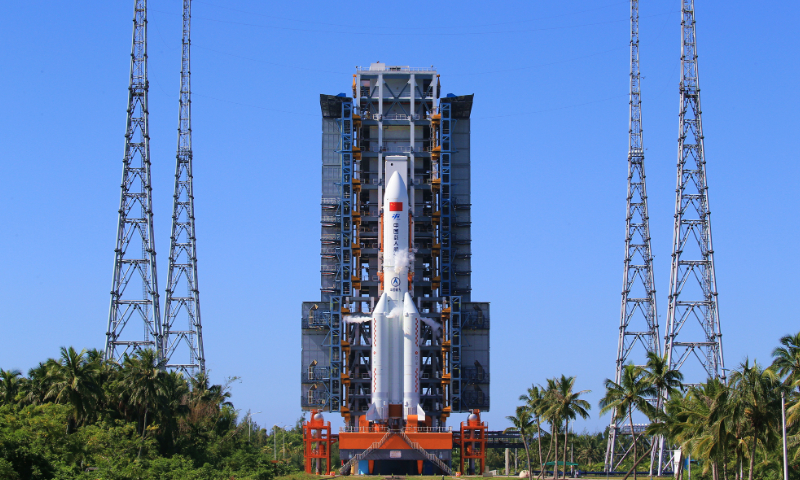
Photo: Combination of China's space station lab module Wentian and Long March-5B Y3 carrier rocket at the Wenchang Space Launch Site on July 24, 2022 Photo: Tu Haichao
'Mini space station'
Dubbed the "heaviest buddy" among all single space modules in active service in the world, Wentian is the second of the three-module basic T-shape structure of the China Space Station, following the first 16-meter-long Tianhe core module launched in April 2021.
The future expanded structure of the China Space Station is going to reach a final total weight of over 180 tons, according to Chinese manned space authorities. Now with Wentian being docked to the Tianhe, the weight of the space station combination has already reached some 50 tons.
With an all-inclusive systems and functions equipped on Wentian, the lab module has been regarded by some observers as a "mini space station." Can the all-round technology in the module offer the possibility of adding new modules to the Chinese space station in the future to further expand its scale and function?
Liang Xiaofeng, the chief electricity designer of Wentian, told the Global Times that from a technical point of view, Wentian has paved the way for the expansion, but subsequent plans will be in accordance with the overall project. "We will have to analyze and sort out the needs for each plan, but we definitely have acquired the key technologies [for module expansion] in reserve."
Future modules to be added to the T-shape basic structure could be foreign spacecraft such as lab modules or manned spacecraft, Pang Zhihao, a senior space expert, told the Global Times.
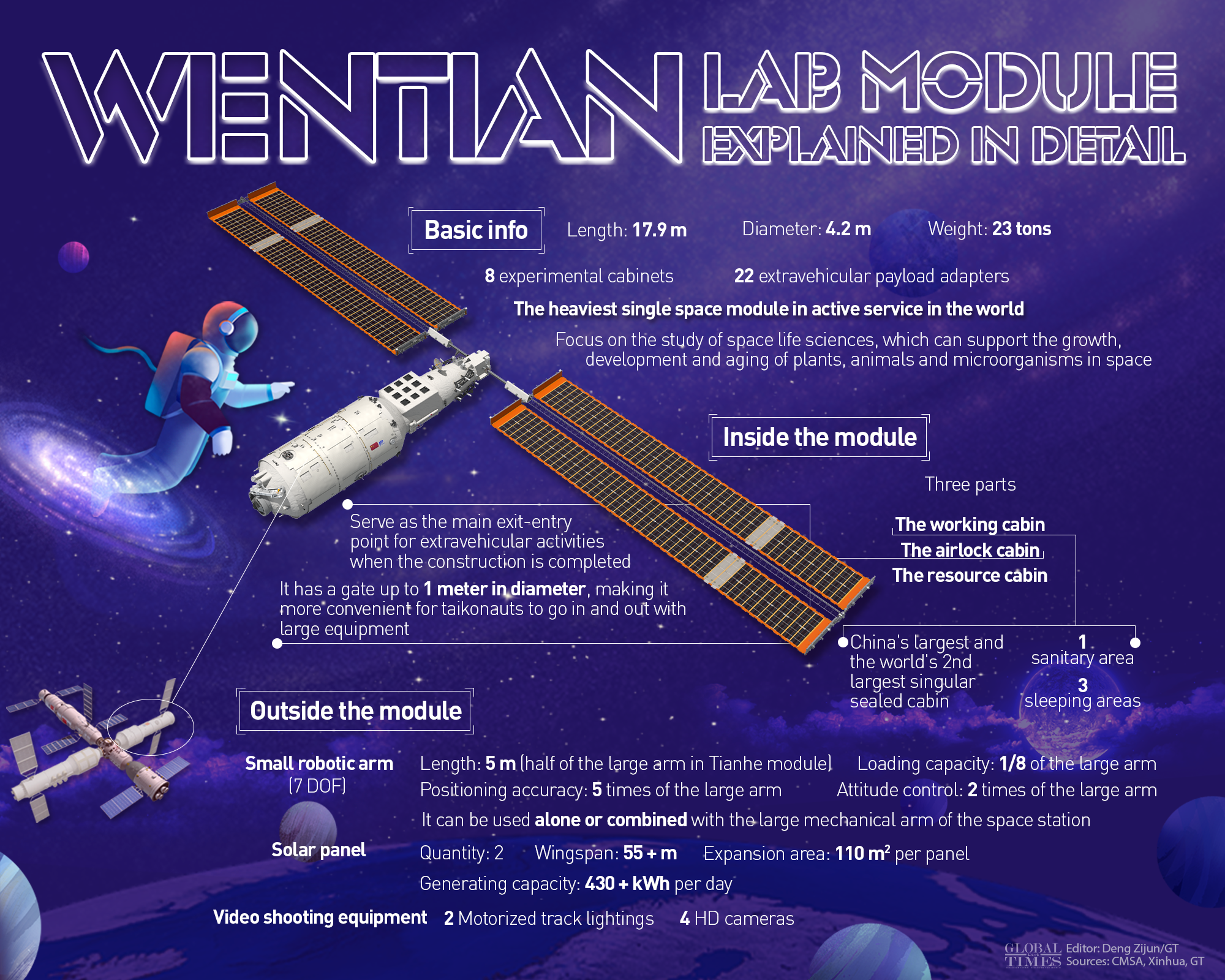
Wentian lab module explained in detail. Graphic: Deng Zijun/GT
Doubling space 'living room'
Summarizing the functions of the lab module, the state owned space giant China Aerospace Science and Technology Corp (CASC), the major contractor of the space station program, said in a statement sent to the Global Times that Wentian is mainly designed with the ability of unified management and control of the station assembly, as well as ability to dock, transpose and park at the core cabin.
It will also support taikonauts' stay in orbit by providing a special airlock cabin and emergency shelter to ensure their safety during extravehicular activities or spacewalk missions, and support various scientific experiments in and outside the cabins.
To start with, with Wentian docked to the space station combination, the living and working area for the taikonauts will instantly be doubled. Also, the bigger-diameter airlock of Wentian would facilitate the crew's spacewalking missions, an obvious change for the better to the crew, among others.
The key platform functions of Wentian are the same with those on Tianhe, meaning that the two would serve as each other's backup, and both of them are capable of covering all task requirements needed for the assembly, the CASC said.
Weighing 23 tons at launch, Wentian consists of three parts: a working cabin, an airlock cabin and a resource cabin, with a total length of 17.9 meters, and a diameter of 4.2 meters.
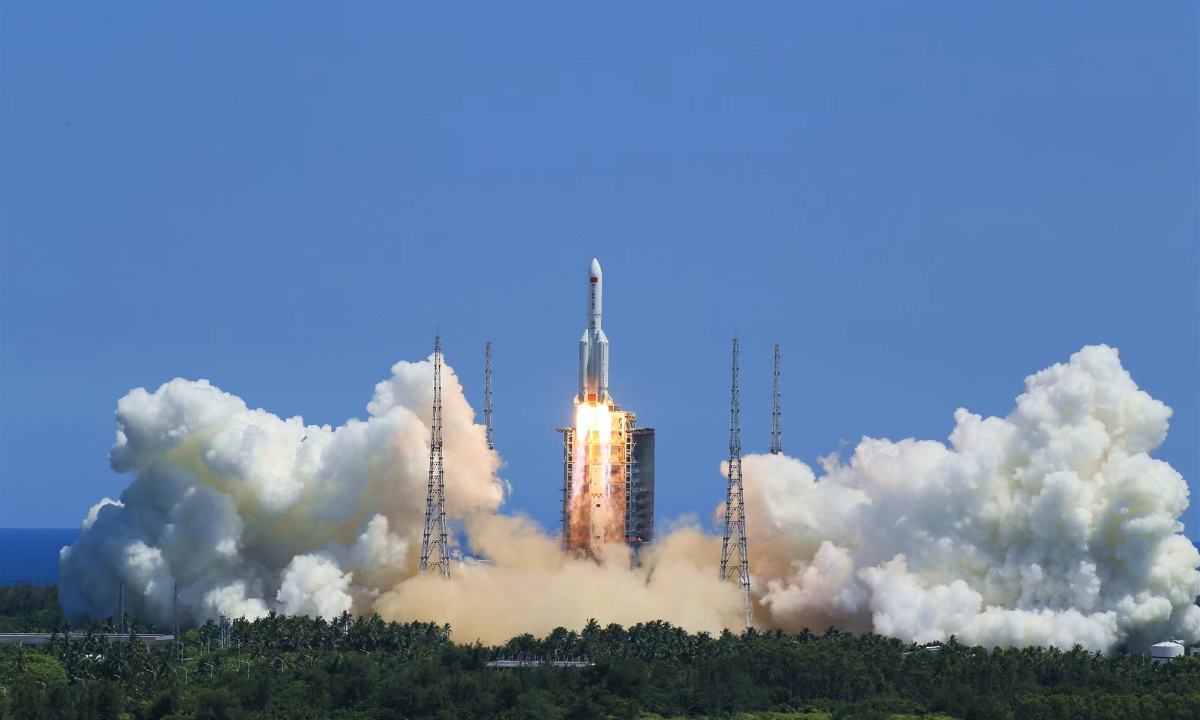
China launches Wentian lab module for space station. Photo: Huang Guochang
It is about the same weight as a carriage of the Beijing subway, even larger than the Tianhe core cabin which is 16.6 meters long and weighing 22.5 tons. Wentian is also heavier than any other single-module spacecraft with flight function that remains in active service, including those deployed in the International Space Station, according to the CASC.
The working cabin of Wentian is by far China's largest singular-sealed cabin, including three sleeping areas and one sanitary area. Upon docking, the space station will be able to accommodate six astronauts. That is to say that when the Shenzhou-15 mission crew meets the Shenzhou-14 for rotation in space, Li Jinlin, a chief designer of extravehicular suits at the Astronaut System under China Manned Space Agency, told the Global Times.
The airlock cabin has a unique shape - square outside but round inside. It is an "upgraded version" of the one in the core module, expanding the "fitting room" for astronauts to change into space suits and prepare for their spacewalking missions, and a one-meter-diameter gate, enabling a more convenient exit and entry for the astronauts, while also allowing them to carry larger equipment outside the cabin.
Therefore, the airlock cabin of Wentian will become the main exit-entry point for extravehicular activities, while the previous one in Tianhe will serve as backup.
Meanwhile, with two exit-entry cabins, they will greatly boost the reliability and better ensure the safety of taikonauts in case of emergency during extravehicular works, Li said.
Outside the airlock cabin are 22 extravehicular payload interfaces. In the next decade, experimental payloads delivered to the space station will be accurately "plugged in" to their corresponding interfaces through the help of robotic arms, no longer needing manual operation of astronauts, CASC revealed to the Global Times.
Apart from the 22 interfaces, Wentian lab has also host eight experimental cabinets. It will mainly focus on the study of space life sciences, which can support the growth, development, genetics and aging of multiple species of plants, animals and microorganisms under space conditions, Lü Congmin, a research fellow at the Chinese Academy of Sciences and deputy chief designer of the space utilization system of China Manned Space, told the Global Times.
More than 10 research directions have been planned and over 40 scientific projects have been established for Wentian, Lü said.
The other lab module Mengtian for the China Space Station, scheduled to be launched in October, will be oriented to microgravity scientific research and is equipped with experimental cabinets for fluid physics, materials science, combustion science, basic physics and space technology experiments.
Another highlight of the Wentian lab module is a five-meter-long small robotic arm installed outside the airlock cabin. With seven degrees of freedom, the set has a higher precision and flexibility to "grasp" small and medium-sized equipment, and is capable of more delicate operations than the bigger robotic arm with the Tianhe module.
The weight and length of the small robotic arm are about half of the large one on the Tianhe core cabin, and the load capacity is about one-eighth of the large arm. When combined, they will have a total length of 15 meters, and will be able to "climb" over all the three modules of Tianhe, Wentian and Mengtian in the future.
Apart from its extra large size, Wentian has a set of extraordinarily-long wings - flexible solar panels with double degrees of freedom. The full wingspan is over 55 meters, longer than half a soccer field, setting a new record for solar panels used for China's spacecraft. Each panel has an unfolded area of about 110 square meters.
The two solar panels will effectively collect more solar energy, generating an average of more than 430 kilowatt hours per day and providing sufficient power for space station operations. If placed on Earth, the daily power generation of the solar panels is enough to support the power demand of an average Beijing household for a month and a half.
By the completion of the space station, one of the solar panels of Tianhe will be transferred to the back of Wentian, and by then the core module will focus solely on the operation of the station, while the lab module will become the main "power house."

